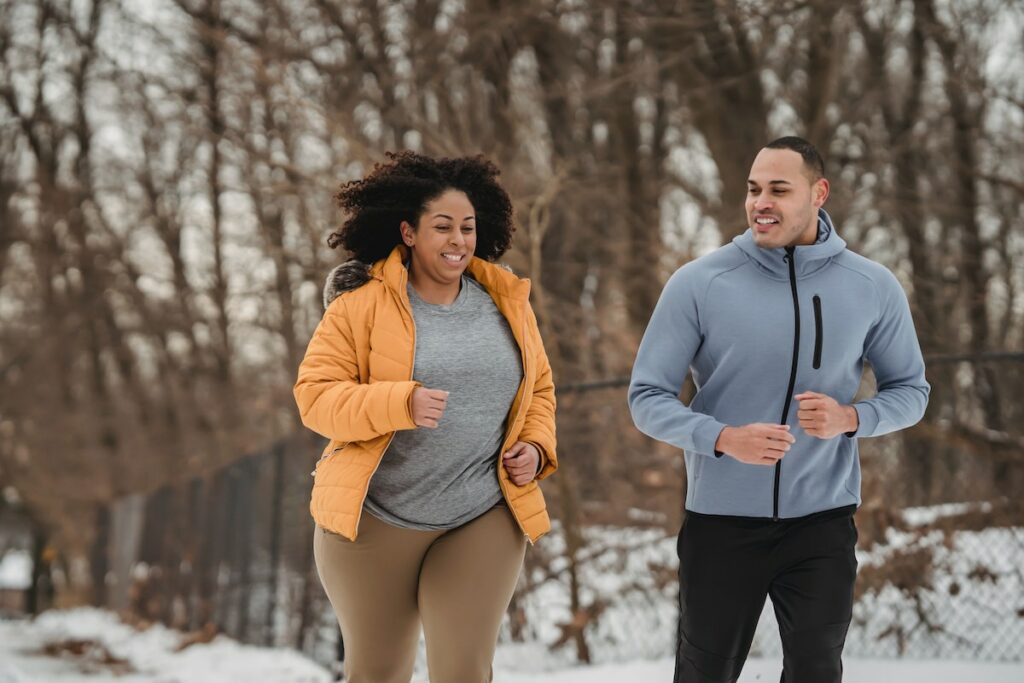How to Become an All-Weather Runner This Winter
At the beginning of summer 2022, I was living my best Chicago runner life. I was waking up at the crack of dawn to meet the 7 on Sundays crew for Blue Bridge workouts, hitting speedwork on Wednesday mornings with my CARA family, and dropping in on other group workouts throughout the week. This blissful routine came to a quick end when I developed a stress fracture and could no longer run.
Summer running is something I always look forward to because the community is strong and the miles feel effortless, so I was bummed to say the least. To make matters more complex, I wasn’t cleared for longer runs until a bit later into the fall season which means my return to running was going to be full of winter mileage.
I’ve always considered myself to be a gritty athlete and have pushed myself to run in some not-so-great conditions, but it’s safe to say that winter running is its own beast. Though it can be challenging, that doesn’t mean it can’t be fun or rewarding. Below are some tips on how to set yourself up for your best winter run.

Acquire the appropriate running attire for the winter.
This piece of advice is for both comfort and safety. If you’re not wearing the appropriate attire for winter running, you’ll likely feel discomfort and may put yourself at risk of hypothermia or frost bite. Some recommendations for what types of attire to work into your routine can be found here. In general, I recommend layers, sweat-wicking materials, and winterized shoes.
Spend time warming up and cooling down before and after your workout.
While a warm up and cool down should be a part of any workout, it’s pretty easy to get warm during the spring, summer, and fall months. Warming up your muscles before a winter run is essential to prevent injury and manage the mental frustration of running in cold weather. I recommend doing static and moving exercises in your home and easing into your run at a slower pace before kicking it into higher gear. When you are finish running, be sure to stretch while your muscles are still warm and consume warmer liquids to keep your body temperature regulated.
Be flexible with your training schedule.
While training for a spring marathon last year, I quickly learned I had to be flexible with my training. Sometimes, it’s simply too cold or too icy to get quality work done. When planning your runs for the week, give yourself some wiggle room in case getting outside isn’t accessible. Additionally, if you prefer to run during daylight hours, it may be necessary to move your run to the late morning or afternoon.
Don’t be afraid to use a treadmill.
Part of being flexible with a training schedule is being open to running on a treadmill. While I’ve certainly been known to refer to this tool as the “dreadmill,” I’ve opened my mind to the powers of this machine. Treadmills are great for completing quality speed work or fitting a run in when it may not feel safe to run outside. You can also adjust elevation, complete group runs with Peloton or Zwift, or catch up on your favorite shows while on a treadmill. Don’t knock it until you try it!
Join a running or fitness club that meets year-round.
Accountability is an excellent motivator for anyone working toward a goal. Running alone in the cold winter miles may not feel super enjoyable, but running with friends and grabbing coffee after does! Many organizations and groups like Tracksmith, November Project, and Lululemon host runs and workouts year-round. I recommend using Strava and social media to find outdoor groups near you.
Set attainable goals to work toward.
Having a goal in mind can help encourage you to get your miles in during the winter months. For many, having a race to look forward to helps build this motivation. Other goals that may be useful can be distance or speed related. For example, you may set the goal that you want to lower your personal best in the mile by 30 seconds or that you want to run 10 miles. These types of goals allow us to key in on why we’re running in the first place.
Mix other types of exercise into your routine.
Part of being a winter running warrior may be allowing yourself to also enjoy other types of exercise. As there aren’t many races during the winter months, it’s an excellent time to focus on building strength and mobility to proactively protect against injury. It’s okay if your mileage is a bit lower while you focus on other areas. Some of my favorite winter fitness activities include yoga, Pilates, and swimming (inside, of course)!
The bottom line: As with all advice, I hope you can take what works for you and leave the rest. As a seasoned winter runner, I can attest to the belief that running winter miles has made me a stronger and more adaptable athlete. While it has its challenges, it can also be full of fun and exciting surprises. Good luck and stay warm!












